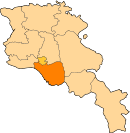Vedi
Vedi (Armenian: Վեդի), is a town and urban municipal community in the Ararat Province of Armenia, located along the Vedi river, 35 kilometres (22 miles) south of the capital Yerevan, and 18 kilometres (11 miles) southeast of the provincial centre Artashat. According to the 2011 census, the population of the town was 11,384. As per the 2016 official estimate, Vedi has a population of around 10,600.
Vedi Վեդի | |
|---|---|
 Vedi | |
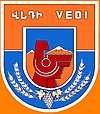 Coat of arms | |
 Vedi | |
| Coordinates: 39°54′38″N 44°43′40″E | |
| Country | Armenia |
| Province | Ararat |
| First mentioned | 13th century |
| Government | |
| • Mayor | Varuzhan Barseghyan[1] |
| Area | |
| • Total | 5.6 km2 (2.2 sq mi) |
| Elevation | 900 m (3,000 ft) |
| Population (2015 census) | |
| • Total | 11,600 |
| • Density | 2,100/km2 (5,400/sq mi) |
| Time zone | UTC+4 (GMT) |
| Postal code | 601 |
| Area code(s) | (+374) 234 |
| Website | Official website |
| Sources: Population[2] | |
Etymology
The name Vedi is derived from the Arabic word wadi (Arabic: وادي), meaning valley. It may have been incorporated into Armenian through the Persian language. The town has been occasionally known as Verin Vedi (Upper Vedi in Armenian) resp. Böyük Vedi (Great Vedi in Azerbaijani). It was officially renamed Vedi in 1946.[3]
History
The territory of Vedi has been settled since the Urartian period. However, the name Vedi was first mentioned during the 13th century by historian Stephen Orbelian in his book History of the Province of Syunik.[4]
Vedi has been a considerably large settlement until the 17th century. At the beginning of the 19th century, it had around 250 families with a 95% majority of Caucasian Tatars (nowadays known as Azerbaijanis) and 5% of Armenians.
Following the Russo-Persian War of 1826–1828 and the signing of the Treaty of Turkmenchay between Qajar Iran and the Russian Empire in 1828, Vedi became part of Imperial Russia. During the 1830s, around 500 Armenians were allowed to move from the Persian city of Maku to Böyük Vedi. In 1849, the settlement became part of the Erivan Governorate of the Russian Empire.
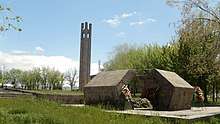
During the 2nd decade of the 20th century, Many Western Armenian families from the Ottoman cities of Van, Shatakh and Muş have migrated to Vedi, escaping the Armenian Genocide.[5]
In 1918, Böyük Vedi became a separate gavar (administrative district) within the independent republic of Armenia.
Following the Sovietization of Armenia, Böyük Vedi became the part of the newly-formed Vedi raion in 1930. In 1946, the settlement was officially renamed Vedi. During the 1940s and 1950s, Armenian population became majority in Vedi, through a new wave of resettled families from the areas of Sisian, Yeghegnadzor and Martuni. In 1963, Vedi was given the status of an urban-type settlement. In 1968, the Vedi raion was renamed Ararat raion.
After the independence of Armenia, Vedi was given the status of a town as per the administrative reforms of 1995.
Geography
Vedi is located around 35 km south of the capital Yerevan, on the right bank of Vedi river, at the eastern part of the fertile Ararat plain. The town has an average height of 900 meters above sea level. The Goravan semi-desert forms a natural border at the south of the town, while the mountains of Urts form the natural borders of Vedi from the north.
The climate of Vedi is characterized with extremely cold and snowy winters. The temperature could reach down to -32 °C during the month of December. Summer is relatively hot in Vedi extending between May and October, with an average temperature of 25 °C. Average precipitation level is around 225 mm annually.
Demographics
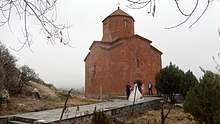
With the Persian occupation of Eastern Armenia at the beginning of the 16th century, Caucasian Tatars have been resettled with large numbers in the Armenian settlements. After the Russian occupation in 1828, Armenian migrants from Maku arrived in Vedi. Western Armenian families from Van, Shatakh and Muş were resettled in Vedi as a result of the Armenian Genocide. However, Vedi remained a settlement with a majority of Caucasian Tatars until the 1940s when Armenians from Sisian, Yeghegnadzor and Martuni were resettled in the town. Thus, Vedi is considered a highly diversified town in term of the cultural and regional background of its citizens.
Currently, Vedi is almost entirely populated by Armenians who belong to the Armenian Apostolic Church. The town's Holy Mother of God Church opened in 2000, is under the jurisdiction of the Araratian Pontifical Diocese based in Yerevan.
Here is the population timeline of Vedi since 1831:
| Year | 1831 | 1897 | 1937 | 1959 | 1970 | 1989 | 2001 | 2011 | 2016 |
|---|---|---|---|---|---|---|---|---|---|
| Population | 1,244 | 2,798 | 2,830 | 3,581 | 6,165 | 10,757 | 12,963 | 11,384 | 10,600 |
Culture
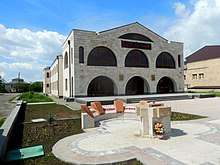
The house culture in Vedi was opened during the 1930s. In 2013, a new palace was built housing the town's theatre and other cultural faculties. The house has its theatre group (founded in 1950), folk instruments ensemble (1977), dance group, brass band, and children's orchestra. During summers, the house of culture organizes the musical Thursdays of Vedi at the open-air amphitheatre of the central park of the town.
The Paruyr Sevak public library of Vedi is operating since 1935. It houses around 58,000 books. The town has also its school of music and school of art.
Transportation
Vedi is located 7 km east of the M-2 Motorway of Armenia. The H-10 regional road connects the town with the motorway. The H-10 extends further to the southeast reaching the Vayots Dzor Province.
Vedi is connected with the capital Yerevan through regular minis bus daily trips.
Economy
Vedi and the surrounding territories are a major centre for agricultural and dairy products in Armenia. Most of the citizens are mainly involved in agricultural activities. Main crops are grape and apricot. Home-made wine is very common in Vedi.
The VediAlco founded in 1956, is among the prominent wine and brandy producers in Armenia,[6] It is notable for its semi-sweet wine of Vernashen.
Education
As of 2017, Vedi is home 2 primary school, 1 high school, and 4 pre-school kindergartens.
Sport
Like most of the regions in Armenia, football is the most popular sport in Vedi. A municipal sport school is operating within the territory of the town's central park of the town with a football training ground, swimming pool, indoor sports hall and other facilities.
Notable people
- Narek Baveyan, Armenian singer and actor
See also
- Ararat plain
References
| Wikimedia Commons has media related to Vedi. |
